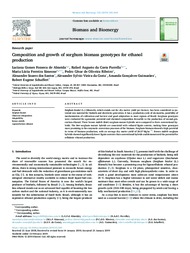Composition and growth of sorghum biomass genotypes for ethanol production.
Composition and growth of sorghum biomass genotypes for ethanol production.
Autoria: ALMEIDA, L. G. F. de; PARRELLA, R. A. da C.; SIMEONE, M. L. F.; RIBEIRO, P. C. de O.; SANTOS, A. S. dos; COSTA, A. S. V. da; GUIMARAES, A. G.; SCHAFFERT, R. E.
Resumo: Sorghum bicolor (L.) (Moench), which stands out for dry matter yield per hectare, has been considered as potential raw material for biofuels and electricity generation. It has a production cycle of six months, possibility of mechanization of cultivation and harvest and good adaptation to most regions of Brazil. Sorghum genotypes were evaluated for agronomic potential and chemical composition favorable to the production of second-generation ethanol. Three brown midrib (bmr) sorghum mutant hybrids were compared to three conventional hybrids. The bmr sorghum mutant hybrids are associated with reduced lignin content, making these genotypes morepromisingtotheenzymaticconversionprocessesofthebiomass.Sorghumbiomassshowedahighpotential in terms of biomass production, with an average dry matter yield of 26.57Mgha−1. Brown midrib sorghum hybrids showed significantlylower lignincontents than conventional hybrids and demonstrated the potential for cellulosic ethanol production.
Ano de publicação: 2019
Tipo de publicação: Artigo de periódico
Unidade: Embrapa Milho e Sorgo
Palavras-chave: Composição Química, Etanol lignocelulósico, Nervura, Sorghum Bicolor
Observações
1 - Por padrão são exibidas publicações dos últimos 20 anos. Para encontrar publicações mais antigas, configure o filtro ano de publicação, colocando o ano a partir do qual você deseja encontrar publicações. O filtro está na coluna da esquerda na busca acima.
2 - Para ler algumas publicações da Embrapa (apenas as que estão em formato ePub), é necessário ter, no celular ou computador, um desses softwares gratuitos. Sistemas Android: Google Play Livros; IOS: iBooks; Windows e Linux: software Calibre.
Acesse outras publicações
Acesse a Base de Dados da Pesquisa Agropecuária (BDPA) para consultar o acervo completo das bibliotecas da Embrapa.

